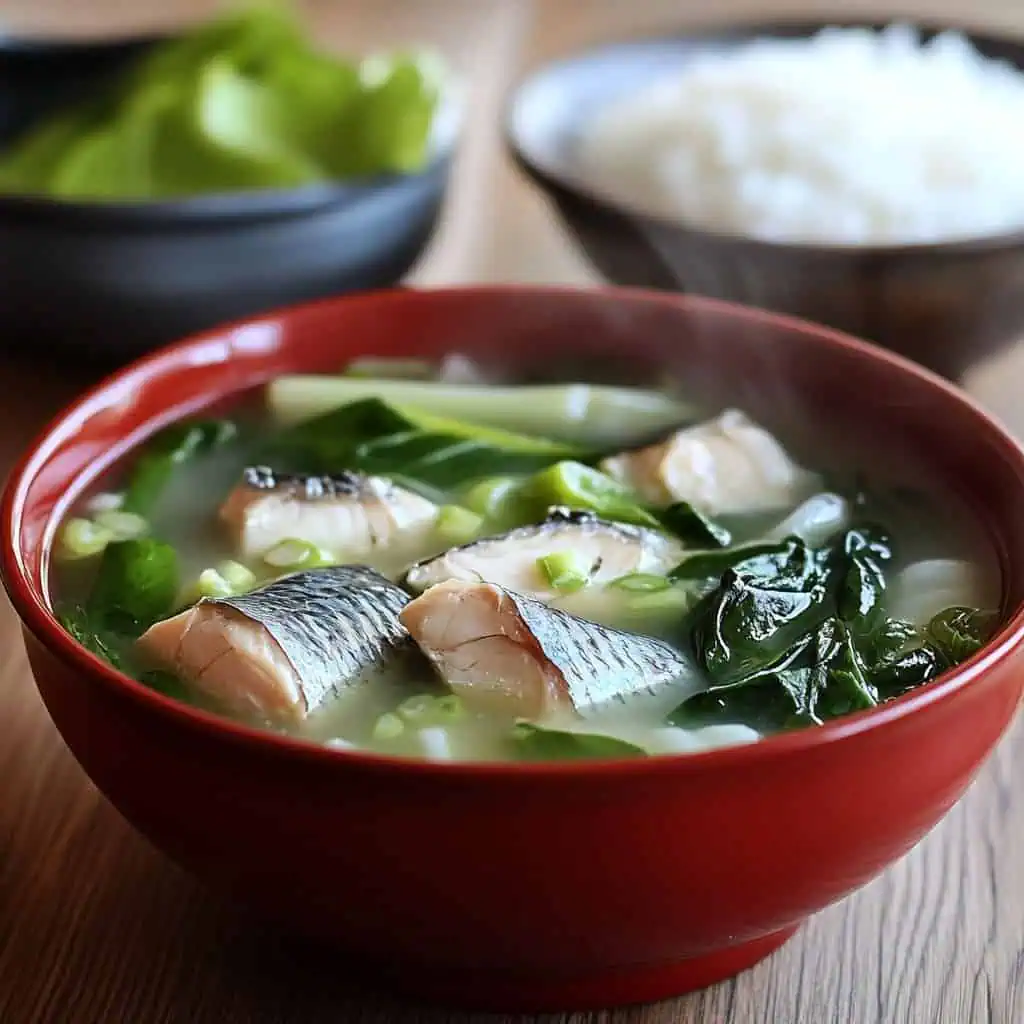There's nothing quite like a warm bowl of Sinabawang Isda when you need some serious comfort food. I discovered this recipe after way too many late nights with my college friends, you know those nights where you promise yourself "just one more drink" but somehow end up watching the sunrise?
My lola used to make this exact soup whenever I'd stumble home looking like I'd been hit by a truck. The clear, ginger-spiked broth with tender fish and that amazing lemongrass aroma works like magic on a queasy stomach. It's light enough that you won't feel worse, but hearty enough to actually make you feel human again.
Plus, it only takes 20 minutes to make, which is perfect when you can barely function but desperately need real food.

Why You'll Love This Recipe
This traditional Filipino fish soup is pure comfort in a bowl! The aromatic lemongrass creates the most incredible fragrance while simmering, and the clear, light broth lets the fresh fish flavors shine through beautifully. It's incredibly healthy, takes just 20 minutes from start to finish, and uses simple ingredients you can find at any Asian market.
The combination of ginger and lemongrass makes this soup naturally soothing - perfect when you're feeling under the weather or just want something nourishing and delicious.
Jump to:
Ingredients
- 1 pound fresh mackerel, cut into serving pieces
- 1 pound baby bok choy, cleaned and trimmed
- 1 thumb-sized piece fresh ginger, peeled and sliced
- 3-5 large garlic cloves, peeled and smashed
- 1 medium red onion, quartered
- 2 medium tomatoes, quartered
- 1 long green chili (siling haba)
- 1 stalk fresh lemongrass, cleaned and bruised
- 2 tablespoons fish sauce
- 8 cups water

I chose these ingredients because they create the perfect balance of flavors that define authentic Sinabawang Isda. The aromatics - ginger, garlic, onion, and lemongrass - build a fragrant base, while tomatoes add natural sweetness and acidity.
Fresh mackerel provides rich, flaky texture, and the bok choy adds a lovely crunch and nutrients to make this a complete, satisfying meal.
Equipment
- Large pot or stockpot - for simmering the soup and accommodating all ingredients comfortably
- Sharp knife - for cutting fish, vegetables, and aromatics cleanly
- Cutting board - for safe food preparation
- Ladle - for serving the soup without breaking the delicate fish pieces

How To Make
- Start by heating 8 cups of water in your large pot over medium-high heat until it reaches a rolling boil.
- Add the sliced ginger, smashed garlic cloves, quartered onion, quartered tomatoes, green chili, and bruised lemongrass stalk to the boiling water. Let this aromatic mixture simmer for 10 minutes to allow all the flavors to infuse into the broth, you'll notice the wonderful fragrance filling your kitchen.
- Gently add the fish pieces to the pot, being careful not to splash, and cook for 7 minutes or until the fish is completely opaque and flakes easily. Stir in the fish sauce, which will add that essential umami depth to the broth.
- Add the bok choy to the pot and gently stir to ensure all pieces are submerged in the flavorful broth. Cook for just 1-2 minutes more until the bok choy is bright green and tender-crisp.
- Turn off the heat and carefully remove the lemongrass stalk using tongs or a spoon. Serve immediately in bowls alongside steamed white rice.

Tips from Lola's Kitchen
- Bruise the lemongrass with the back of your knife before adding - this releases more flavor
- Don't overcook the fish or it will fall apart and make the soup cloudy
- I always taste the broth before adding fish sauce - some brands are saltier than others
- Add the bok choy stems first, then the leaves 30 seconds later for even cooking
- For extra flavor, sauté the aromatics in a bit of oil before adding water
Substitutions
- Fish: Use tilapia, bangus (milkfish), or any firm white fish instead of mackerel
- Vegetables: Substitute with kangkong (water spinach), mustard greens, or regular cabbage
- Lemongrass: If unavailable, add a strip of lemon zest (remove before serving)
- Fish sauce: Replace with salt to taste, though you'll lose some umami depth
- Green chili: Use jalapeño or serrano peppers for similar heat level
Troubleshooting
- Cloudy broth: This happens when the water boils too vigorously - keep it at a gentle simmer
- Fishy smell: Always use the freshest fish possible and don't overcook it
- Too salty: Add more water and adjust seasoning gradually
- Bland soup: Let the aromatics simmer longer before adding fish, or add more ginger
- Overcooked vegetables: Add them in the last 1-2 minutes of cooking only
Storage & Reheating
- Store leftover soup in the refrigerator for up to 2 days in a covered container
- I don't recommend freezing as the fish texture becomes mushy when thawed
- Reheat gently on the stovetop over low heat - don't boil or the fish will break apart
- Add fresh bok choy when reheating if the original vegetables became too soft
- The flavors actually develop more overnight, making leftovers even more delicious

FAQ
Can I use frozen fish?
Yes, but thaw completely and pat dry before cooking for best results
How do I know when the fish is done?
It should be opaque throughout and flake easily with a fork
Can I make this ahead?
I prepare all the vegetables in advance, but cook the soup fresh for best texture
What rice goes best with this?
Plain steamed jasmine rice is traditional and perfect for soaking up the broth
Is this soup spicy?
It has mild heat from the green chili, remove seeds for less spice
Can kids eat this?
Absolutely! Just remove the chili or use a milder pepper variety
Related
Looking for other recipes like this? Try these:

Sinabawang Isda (Filipino Fish Soup)
Ingredients
- 1 pound fresh mackerel cut into serving pieces
- 1 pound baby bok choy cleaned and trimmed
- 1 thumb-sized piece fresh ginger peeled and sliced
- 3-5 large garlic cloves peeled and smashed
- 1 medium red onion quartered
- 2 medium tomatoes quartered
- 1 long green chili siling haba
- 1 stalk fresh lemongrass cleaned and bruised
- 2 tablespoons fish sauce
- 8 cups water
Instructions
- Start by heating 8 cups of water in your large pot over medium-high heat until it reaches a rolling boil.
- Add the sliced ginger, smashed garlic cloves, quartered onion, quartered tomatoes, green chili, and bruised lemongrass stalk to the boiling water. Let this aromatic mixture simmer for 10 minutes to allow all the flavors to infuse into the broth, you'll notice the wonderful fragrance filling your kitchen.
- Gently add the fish pieces to the pot, being careful not to splash, and cook for 7 minutes or until the fish is completely opaque and flakes easily. Stir in the fish sauce, which will add that essential umami depth to the broth.
- Add the bok choy to the pot and gently stir to ensure all pieces are submerged in the flavorful broth. Cook for just 1-2 minutes more until the bok choy is bright green and tender-crisp.
- Turn off the heat and carefully remove the lemongrass stalk using tongs or a spoon. Serve immediately in bowls alongside steamed white rice.
Tips from Lola's Kitchen
- Bruise the lemongrass with the back of your knife before adding - this releases more flavor
- Don't overcook the fish or it will fall apart and make the soup cloudy
- I always taste the broth before adding fish sauce - some brands are saltier than others
- Add the bok choy stems first, then the leaves 30 seconds later for even cooking
- For extra flavor, sauté the aromatics in a bit of oil before adding water
The Story Behind Sinabawang Isda
Sinabawang Isda has been a cornerstone of Filipino home cooking for generations, born from the practical wisdom of coastal families who understood how to transform the day's fresh catch into nourishing comfort food. The name literally translates to "fish in broth," which perfectly captures this dish's beautifully simple essence. Along the Philippines' extensive coastline, fishing communities developed countless variations of this soup, each family adding their own signature touches while maintaining the core principle of letting fresh fish shine in a clean, flavorful broth.
The genius of Sinabawang Isda lies in its accessibility and adaptability. Filipino cooks have long relied on this recipe as their go-to solution for using whatever fish was available, whether it's the day's market catch or leftovers from a larger meal. The cooking method reflects traditional Filipino values of resourcefulness and community - the soup easily scales up to feed unexpected guests, and the gentle cooking process ensures even novice cooks can achieve delicious results.
What makes this soup distinctly Filipino is the use of indigenous ingredients like lemongrass and siling haba (long green chilies), combined with the Spanish-influenced sofrito base of garlic, onions, and tomatoes. This fusion represents the beautiful complexity of Filipino cuisine, where indigenous techniques meet foreign influences to create something entirely unique. The addition of leafy greens like bok choy or kangkong reflects the Filipino tradition of incorporating fresh vegetables into every meal for balanced nutrition.
Today, Sinabawang Isda remains a beloved comfort food across Filipino households worldwide. It's the soup that appears on dinner tables during rainy season, the remedy grandmothers prepare for family members feeling under the weather, and the simple pleasure that connects Filipino families to their culinary heritage. The recipe's enduring popularity proves that sometimes the most satisfying dishes are also the most straightforward - fresh ingredients, time-honored techniques, and the love that goes into every bowl.










Comments
No Comments